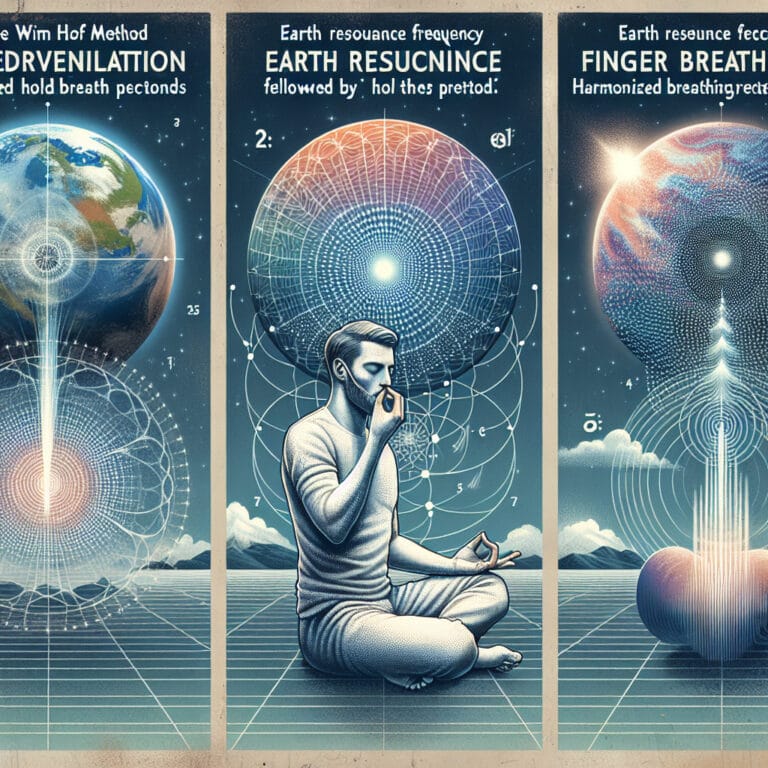
Mastering the Art of Guided Breathing Meditation: A Comprehensive Guide for Beginners
Table of Contents
- Introduction: The Importance of Guided Breathing Meditation
- Understanding Guided Breathing Meditation: Definition, Types, and Benefits
- Preparing for Guided Breathing Meditation: Choosing the Right Environment and Time
- Step-by-Step Guide to Mastering Guided Breathing Meditation
- Common Mistakes to Avoid in Guided Breathing Meditation
- Tips and Tricks for Enhancing Your Guided Breathing Meditation Experience
- Conclusion: Embracing Guided Breathing Meditation for a Healthier Life
- Frequently Asked Questions
Introduction: The Importance of Guided Breathing Meditation
Dedicating time to the practice of guided breathing meditation can yield a myriad of benefits for one’s overall well-being, offering relief from daily stressors and anxiety triggers. As we navigate an increasingly fast-paced world, the importance and popularity of such meditative practices have surged. At its core, guided breathing meditation centralizes on the very essence of life – breath. It encourages individuals to take a step back from their overactive minds and cultivate a safe environment within themselves.
A significant benefit that this practice offers is managing panic attacks. By using deep breaths as an anchor during moments of intense fear or discomfort, individuals can regain control over their nervous systems. The Wim Hof Method has gained traction in this realm with its unique blend of breathing exercises and cold therapy; it aids in maintaining rhythm during these sessions while also bolstering resilience against stress.
Moreover, methods like finger-breathing guide your concentration towards maintaining steady inhales and exhales – an audiovisual guide that assists in centering attention away from distressing thoughts. By simply watching or hearing someone breathe alongside you through interactive tools, you create space for calmness amidst chaos.
The scientifically-backed Earth Resonance Frequency offers further benefits by syncing our biological rhythms with that of the Earth’s natural frequency; inducing relaxation – akin to listening healing music. This form of meditation not only nourishes mental health but also enhances physical vitality by regulating hormonal imbalances.
Finally, engaging with slower-paced Wim Hof method or similar strategies helps increase lung capacity gradually which contributes immensely towards cardiovascular health. So whether you’re a beginner getting grips on basics guided meditation or seeking ice bath challenges for advanced stages; remember that each deep breath custom designed graphic improves your mindful journey towards wellness.
With ample resources available today – ranging from minutes-long guided mindfulness meditations to complete guides – there’s never been a better time to incorporate these techniques into your routine for enhanced physical health and mental tranquility.
Understanding Guided Breathing Meditation: Definition, Types, and Benefits
Guided breathing meditation is an age-old practice steeped in serenity and science. It trains the mind to focus on the rhythm of one’s breath, steering away from the consuming chaos of overactive thoughts. The practice is like a symphony in its variety – from the basics of guided meditation to more advanced techniques such as the Wim Hof method or earth resonance frequency approach.
The Wim Hof method combines controlled breathing exercises with cold therapy. This unique fusion not only helps maintain rhythm during meditative sessions but also boosts resilience against stressors, making it highly effective for individuals prone to panic attacks. Moreover, developing proficiency in this method gradually increases lung capacity contributing significantly towards cardiovascular health.
On another note, earth resonance frequency entwines our biological rhythms with Earth’s natural frequency. Comparable to relaxing with healing music, it induces tranquility and regulates hormonal imbalances enhancing overall vitality. That feeling you get after taking a deep breath? Multiply that by tenfold when you incorporate this technique into your routine.
Finger breathing is yet another technique that guides concentration towards maintaining steady inhales and exhales – serving as an excellent audiovisual guide for beginners or those struggling with anxiety during meditation. By simply watching someone breathe alongside you through interactive tools creates space for calmness amidst chaos – akin to stepping back from distressing thoughts and creating a safe environment within oneself.
The benefits of these varying practices are boundless – mental decompression, increased physical vitality, protection from anxiety symptoms being among them. All it takes is dedicating few minutes each day for guided mindfulness meditation which can dramatically decrease anxiety levels while promoting calmness in one’s life.
Lastly but no less important are slower-paced breathing exercises such as those suggested by Wim Hof Method Practice; not only they offer similar benefits but also cater beautifully to beginners who wish to increase their lung capacity gradually ensuring a safe yet challenging exploration into their mindful journey.
From deep breaths acting as custom designed graphics for peace to the onscreen timer aiding you in maintaining rhythm – the world of guided breathing meditation is a treasure trove waiting to be explored. So why wait? Delve into this practice sitting in your comfortable corner, invite calmness into your life while keeping tinnitus and similar symptoms at bay. It’s time to breathe back control over your well-being.
| Type of Guided Breathing Meditation | Description | Benefits |
|---|---|---|
| Wim Hof Method | Combines controlled breathing exercises with cold therapy | Boosts resilience against stressors, effective for panic attacks, increases lung capacity, contributes to cardiovascular health |
| Earth Resonance Frequency | Entwines our biological rhythms with Earth’s natural frequency | Induces tranquility, regulates hormonal imbalances, enhances overall vitality |
| Finger Breathing | Guides concentration towards maintaining steady inhales and exhales | Excellent for beginners, helps with anxiety during meditation, creates a space for calmness |
| Slower-Paced Breathing | Slower-paced breathing exercises such as those suggested by Wim Hof Method Practice | Offers similar benefits, caters to beginners, helps to increase lung capacity gradually |
Preparing for Guided Breathing Meditation: Choosing the Right Environment and Time
The power of guided breathing meditation lies in its versatility and accessibility, making it a tool available for anyone seeking to cultivate inner peace and manage stress. Did you know that such practices can significantly reduce the impact of panic attacks by using deep breaths as an anchor during moments of intense fear or discomfort? It is like taking control of your nervous system, breathing back into tranquility and safety. These exercises offer not just mental relief but also bodily benefits. Techniques incorporated in the Wim Hof method, combined with cold therapy, contribute immensely towards cardiovascular health by gradually increasing lung capacity.
Choosing an environment that instills comfort and serenity should be prioritized while planning your practice sessions. A place safe from interruptions where you can step back from your overactive mind and immerse yourself in calming rhythms – much like relaxing with healing music – fosters the perfect atmosphere for meditation.
Meditation is not bound by time constraints; however, aligning it with specific periods may enhance its effectiveness. Many meditators find early mornings or late evenings ideal as they’re typically quieter times that provide a natural ambiance for deeper focus.
For beginners who are learning the basics of guided meditation or those battling anxiety during sessions, utilizing an audiovisual guide proves beneficial. Practices like finger breathing provide this support where you simply watch someone breathe alongside through interactive tools; this interaction helps maintain rhythm during your session ensuring consistent inhales and exhales.
From mastering slower-paced Wim Hof method exercises to exploring Earth’s resonance frequency approach – every bit contributes towards creating a harmonious blend between physical vitality and mental tranquility. So whether you’re preparing for an ice bath challenge or setting up an onscreen timer for your daily minutes-long mindfulness practice – remember to breathe deeply – each breath is indeed a custom-designed graphic paving way towards wellness.
Step-by-Step Guide to Mastering Guided Breathing Meditation
Scientific studies and experts in the field have consistently touted the transformative influence of guided breathing meditation on overall well-being. However, mastering this practice necessitates far more than just drawing a deep breath; it’s about understanding the nuances of your nervous system, learning how to calm an overactive mind, and acquiring techniques that facilitate relaxation akin to healing music.
The cornerstone of this therapeutic journey is maintaining rhythm during breathing sessions. Much like a symphony conductor ensures harmony within an orchestra, you too must guide your breaths – inhaling and exhaling at a pace that syncs with your body’s natural rhythm. This task might seem daunting initially but remember: every big accomplishment starts with small steps. Begin by dedicating brief spans – mere minutes for guided mindfulness meditations designed to soothe anxiety. Gradually increase this time as you grow comfortable with the practice.
Amongst numerous beneficial breathing exercises available today, the ‘slower paced Wim Hof method’ has garnered substantial acclaim for its comprehensive approach towards mental tranquility and physical vitality. A complete guide on this method unveils an alchemical blend of slower-paced breathing exercises paired with cold therapy – essentially serving dual purposes of strengthening lung capacity while fortifying resilience against stressors common in our fast-paced lives.
A unique aspect worth noting here is ‘finger-breathing,’ particularly helpful for beginners or those struggling with anxiety during meditation sessions. As an audiovisual guide offering interactive support, it helps keep focus anchored on steady inhales and exhales rather than distressing thoughts or tinnitus symptoms that may surface during practices. Imagine simply having someone breathe alongside you through your session – it’s akin to inviting calmness amidst chaos.
Indeed, guided breathing meditation works wonders in creating a safe environment within oneself – an internal haven where one can retreat from external pressures any moment they wish to step back into serenity; all it requires is consistent practice sitting comfortably in one’s space irrespective of time constraints.
Ultimately, whether you’re exploring the Wim Hof method or experimenting with Earth resonance frequency techniques, remember: every deep breath is a custom-designed graphic – a symbol of your commitment to personal growth and well-being. As you meditate with these easy tips and engage in this practice, know that each breath is not just about breathing back into tranquility but also about breathing life into every moment you exist.
| Key Concepts | Description |
|---|---|
| Understanding Your Nervous System | Crucial for mastering guided breathing meditation. It involves learning to calm an overactive mind and acquiring relaxation techniques. |
| Maintaining Rhythm | The cornerstone of successful guided breathing meditation. Involves inhaling and exhaling at a pace that syncs with your body’s natural rhythm. |
| Starting Small | Begin with short sessions of guided mindfulness meditations. Gradually increase the duration as you grow comfortable with the practice. |
| Wim Hof Method | A slower-paced breathing exercise paired with cold therapy. Known for promoting mental tranquility and physical vitality. |
| Finger-Breathing | An audiovisual guide particularly helpful for beginners or those with anxiety. Helps focus on steady breaths, offering interactive support. |
| Creating a Safe Environment | Guided breathing meditation creates a safe internal space to retreat from external pressures. Requires consistent practice in a comfortable space. |
| Symbolism of Each Breath | Every deep breath is a commitment to personal growth and well-being. It’s not just about breathing back into tranquility, but also about breathing life into every moment. |
Common Mistakes to Avoid in Guided Breathing Meditation
Embarking on a journey towards mastering guided breathing meditation is often marked with initial missteps. One common mistake beginners frequently make involves irregular practice, expecting quick results without consistent effort. Meditation, much like any other skill, requires regular practice and dedication to truly harvest its benefits. Another prevalent misconception is the notion of a ‘perfect’ meditative state where the overactive mind cascades into calm instantly. In reality, achieving tranquility takes time and patience; it’s not uncommon for thoughts to wander during meditation sessions. The key lies in gently guiding your focus back towards your breath each time distractions occur.
Moreover, many novices might not realize the importance of proper posture during these practices; sitting comfortably matters as discomfort can prove distracting and counterproductive to relaxation – akin to healing music being played on an out-of-tune instrument. It’s also important that beginners do not try extreme methods such as ice bath challenges or advanced stages of the Wim Hof Method too early; it’s essential to gradually increase intensity ensuring safety while keeping tinnitus symptoms at bay.
Adopting an audiovisual guide such as finger breathing can be immensely helpful in maintaining rhythm, allowing you to simply watch and hear someone breathe alongside you during interactive guided breathing sessions. This technique offers protection from anxiety by providing a tangible focus away from distressing thoughts – like following a deep breath custom designed graphic.
Understanding these potential pitfalls emphasizes how crucial consistency is in achieving lasting benefits of guided breathing exercises – just minutes spent daily on mindfulness meditation can significantly calm anxiety levels over time. Syncing our biological rhythms with the earth resonance frequency further induces relaxation contributing holistically towards mental resilience and physical vitality.
Guided breathing exercises are indeed potent tools but remember: their power derives not only from theory but also consistent practical application – so whether it’s through basics guided meditation or exploring cold therapy through Wim Hof method practice – ensure each step taken back into tranquility is deeply rooted in dedication and patience.
| Mistake | Description | Solution |
|---|---|---|
| Irregular Practice | Expecting quick results without consistent effort. | Regular practice and dedication to truly harvest its benefits. |
| Seeking ‘Perfect’ Meditative State | Expecting the overactive mind to cascade into calm instantly. | Acknowledge that achieving tranquility takes time and patience; gently guide your focus back towards your breath each time distractions occur. |
| Ignoring Proper Posture | Not realizing the importance of sitting comfortably during practices. | Ensure comfort as discomfort can prove distracting and counterproductive to relaxation. |
| Trying Extreme Methods too Early | Attempting practices such as ice bath challenges or advanced stages of the Wim Hof Method prematurely. | Gradually increase intensity ensuring safety while keeping tinnitus symptoms at bay. |
| Not Using Audiovisual Guides | Not adopting techniques like finger breathing that can help maintain rhythm. | Utilize guides that allow you to watch and hear someone breathe alongside you during interactive guided breathing sessions. |
| Inconsistency in Practice | Not understanding the potential pitfalls in the practice of guided breathing exercises. | Just minutes spent daily on mindfulness meditation can significantly calm anxiety levels over time. |
| Not Syncing with Earth Resonance Frequency | Not syncing biological rhythms with the earth resonance frequency. | Syncing with earth resonance frequency further induces relaxation contributing holistically towards mental resilience and physical vitality. |
| Lack of Practical Application | Not applying the practice of guided breathing exercises consistently. | Whether it’s through basics guided meditation or exploring cold therapy through Wim Hof method practice – ensure each step taken back into tranquility is deeply rooted in dedication and patience. |
Tips and Tricks for Enhancing Your Guided Breathing Meditation Experience
Harnessing the power of guided breathing meditation can change your life in countless ways. With a variety of techniques ranging from simple basics guided meditation to the more advanced practices like the Wim Hof method, these exercises pave the way for a healthier and calmer lifestyle. A significant feature of the Wim Hof method is its integration of cold therapy with breathing exercises, which not only strengthens your nervous system but also boosts mental resilience and physical vitality. This unique blending provides an invigorating experience that takes meditative practices to new heights.
Keeping track of your progress during these sessions is crucial, and numerous apps are available today that can help maintain consistency in this regard. These digital tools serve as an onscreen timer, guiding you through each step of your practice sitting comfortably in your space while also offering interactive guides for advanced techniques like finger breathing or slower paced Wim Hof method breathing exercise.
Furthermore, investing time into earth resonance frequency meditation brings another level of relaxation by aligning our biological rhythms with Earth’s natural frequency – it’s akin to bathing in healing music. The impact? Increased tranquility and reduced signs of anxiety.
Remember, every deep breath you draw is a step towards calmness; each session contributes towards building a safe environment where tinnitus symptoms are kept at bay. So whether you’re battling panic attacks or simply seeking some stillness amidst chaos – remember to breathe easy because every deep breath custom designed graphic leads you back into tranquility.
Conclusion: Embracing Guided Breathing Meditation for a Healthier Life
Embracing the profound benefits of guided breathing meditation can dramatically alter one’s life for the better. From combating panic attacks to promoting overall well-being, this practice is an invaluable tool in today’s fast-paced world. Harnessing techniques such as the Wim Hof method—a harmonious blend of breathing exercises and cold therapy—can serve as a protective shield against stressors, gently guiding an overactive mind back into calmness. Furthermore, practices like finger breathing offer an audiovisual guide that helps maintain rhythm during sessions, making them ideal for beginners or those seeking relief from anxiety symptoms. Incorporating earth resonance frequency techniques can also enhance your meditative experience by aligning biological rhythms with Earth’s natural frequency—the result is akin to immersing yourself in healing music. Even dedicating just a few minutes daily to guided mindfulness meditation can bring about significant improvements in managing anxiety levels and cultivating tranquility. Remember, each deep breath you take while sitting comfortably in your own space is not merely air being drawn into your lungs—it’s a custom-designed graphic symbolizing steps towards mastering peace within oneself. Thus, whether you choose basics guided meditation or opt for more advanced methods like Wim Hof’s ice bath challenge, the journey towards mastering these skills invariably leads to greater mental resilience and physical vitality.



